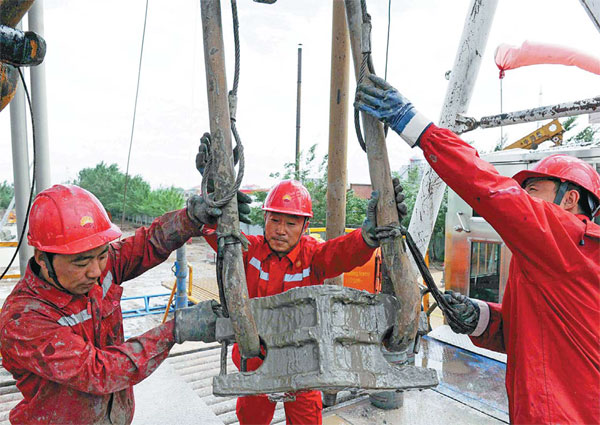Oil majors ponder output cuts as crude prices fall, costs rise
PetroChina to reduce production after decades of over-exploitation
Rising production costs and falling global crude prices are prompting Chinese oil companies to reduce output and explore other options for sustainable profit growth in the long term, a leading industry expert says.
Part of the reason why oil firms are resorting to such measures stems from the over-exploitation of existing oilfields and their resultant inability to maintain output levels due to dwindling resource quality, reserves and higher production costs, says Li Li, research director at ICIS C1 Energy, a Shanghai-based energy information consultancy.
|
Workers at Daqing Oilfield in northeastern China. PetroChina, the country's top oil and gas producer, is cutting output from the oilfield. Wang Song / Xinhua |
"With global crude prices falling steadily, company officials have realized that it is an opportune time to reduce output," she says.
PetroChina, the country's top oil and gas producer that also owns refineries, says that it was cutting output from its largest oilfield in Daqing in northeastern Heilongjiang province starting this year.
Daqing Oilfield plans to reduce output by 1.5 million metric tons this year from the previous levels of about 40 million tons that it had achieved for seven consecutive years.
The oilfield, which accounts for about one-quarter of the national crude output, had earlier achieved 50 million tons of annual output for 27 years, considered a "miracle" in the oil industry.
According to the PetroChina plan, Daqing Oilfield will scale down its annual output to 32 million tons by 2020.
Zhu Chunkai, an analyst with Sublime China Information Co, a commodities consultancy based in Shandong province, says crude output in Daqing is limited by both reserves and technology.
"Considering the falling international oil prices, it is reasonable to cut output because imports will be much more economical," he says.
However, some industry sources say lower output may actually prove beneficial for PetroChina as it will give a fillip to the company's sustainable development plans and encourage it to find new drilling techniques.
Zhang Yonghao, an analyst with Shandong-based commodities consultancy Zibo Zhongyu Information Technology Co, which runs www.chem365.net, says in addition to Daqing, other oilfields including Liaohe Oilfield in Liaoning province and Shengli Oilfield in Shandong province have also passed their production peak periods, and are facing difficulties similar to Daqing's.
"The output from these oilfields is falling rapidly," he says.
Due to the lower output from domestic oilfields, China will have to rely on crude imports to meet its growing demand for oil, experts say.
In recent years, China's oil output has stayed roughly unchanged, while demand surged from 439 million tons in 2009 to 488 million tons in 2013.
The share of imported crude in the overall oil stocks has risen from 36.69 percent in 2005 to 57.39 percent in 2013, according to the CNPC Economics and Technology Research Institute.
In addition to crude imports, acquiring overseas oil and gas assets is another important way to meet the growing domestic demand and ensure energy security, says Lin Boqiang, director of the China Center for Energy Economics Research of Xiamen University.
Chinese energy companies, led by state-owned giants like China National Petroleum Corp, China Petrochemical Corp and China National Offshore Oil Corp, have acquired a number of overseas assets in the past decade.
According to a report from the institute, Chinese companies had 110 million tons of overseas oil and gas output in 2013, up 10 percent compared with the previous year.
In addition, the country has also been making efforts to explore offshore oil and gas resources.
CNOOC, the largest offshore oil and gas producer in the country, said in December that it had 93 offshore oilfields and 13 gas fields in production. In 2014, the company owned 200 offshore production platforms, compared with 146 in 2009.
dujuan@chinadaily.com.cn

























